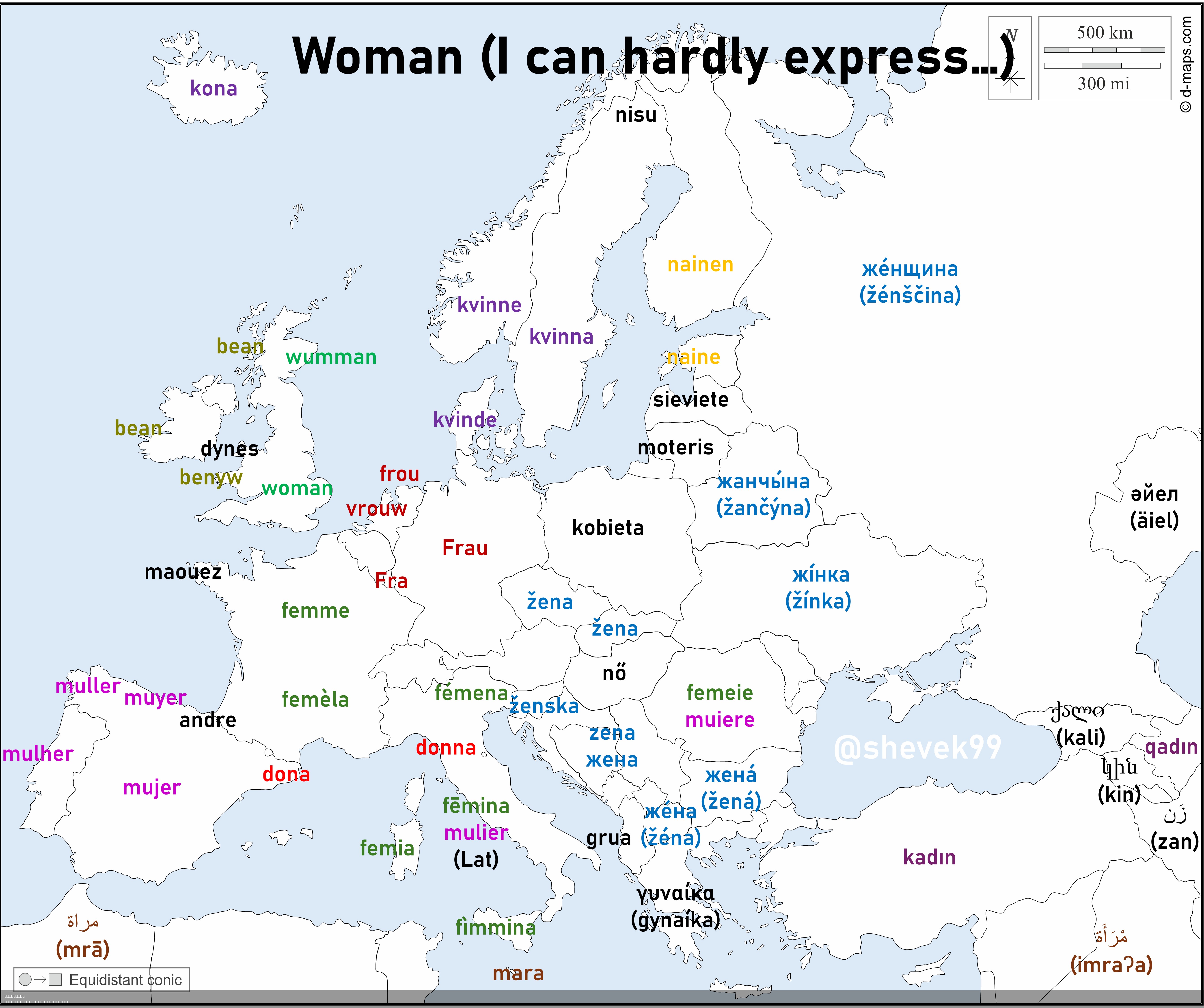Map of the Word for Woman in Different Languages


Alex Cartwright
Senior Cartographer & GIS Specialist
Alex Cartwright is a renowned cartographer and geographic information systems specialist with over 15 years of experience in spatial analysis and data...
Geographic Analysis
What This Map Shows
This map provides a captivating look at how the term "woman" is expressed in various languages around the globe. It visually illustrates the linguistic diversity that exists in our world, highlighting the cultural nuances and historical contexts that shape the way we refer to half of the human population. Interestingly, the English word "woman" has its origins in the phrase "wife of a man," which prompts us to reflect on the evolving societal roles and perceptions of women throughout history. This exploration of language not only reveals how different cultures define and relate to the concept of womanhood but also serves as a reminder of the shared experiences and challenges that women face across borders.
Deep Dive into the Linguistic Landscape of "Woman"
The word for woman varies widely across languages, each carrying its own significance and etymological background. For instance, in Spanish, the term "mujer" is derived from the Latin word "mulier," which also conveys the sense of femininity and nurturance. Similarly, the French word "femme" traces back to the Latin "femina," which has been associated with various roles women have played in society.
What's fascinating is that many languages incorporate elements that reflect cultural attitudes toward women. For example, in Arabic, the word "imra'a" not only refers to a woman but also connects to concepts of honor and family, showcasing the cultural values placed on women's roles in many Middle Eastern societies.
In contrast, languages that have evolved in more egalitarian contexts often present simpler terms without the added implications of gender roles. For example, in Swedish, the word "kvinna" is straightforward and does not carry the weight of historical patriarchy that often accompanies similar terms in other languages. This divergence speaks volumes about how language shapes and is shaped by societal norms and structures.
The representation of women in language isn’t merely a linguistic curiosity; it reflects deeper societal values. For instance, in some cultures, the word for woman might be linked to ideas of strength and independence, while in others, it may still carry connotations of subservience or domesticity. This linguistic exploration can thus unveil broader trends regarding gender equality and women’s rights across different regions.
Regional Analysis
Looking at the map, we can observe significant regional patterns in how the term "woman" is expressed. In Western Europe, languages like English, French, and German showcase a blend of historical influences from Latin and Germanic roots. However, the nuances in meaning can reflect varying attitudes: the German word "Frau" is less rooted in a subservient connotation than its English counterpart.
In contrast, in regions such as South Asia, the terms often derive from ancient languages like Sanskrit and carry connotations tied to social hierarchy and familial roles. The Hindi word "aurat" can sometimes reflect traditional views on women's societal roles. However, as urbanization and globalization increase, the evolution of language in these regions also reflects changing attitudes towards women.
Interestingly, in indigenous languages around the world, the terms for woman often reveal rich cultural contexts and values. For instance, in many Native American languages, the word for woman may be linked to nature or community, illustrating a deep respect for women's roles within the family and society. This connection to the land and community can contrast sharply with the more individualistic interpretations found in modern Western languages.
Significance and Impact
Understanding the various terms for woman across languages is crucial for appreciating the cultural frameworks that shape gender roles globally. Language is not just a tool for communication; it is a reflection of our values, beliefs, and societal structures. As we continue to strive for gender equality, it becomes essential to recognize how language can both reinforce and challenge existing norms.
Moreover, the evolution of language around the term "woman" can signal broader societal changes. For example, as women gain more rights and visibility, we often see a shift in the language used to describe them—moving away from terms that denote possession or subservience towards those that embody strength, independence, and leadership.
As global conversations on gender continue to evolve, so too will the languages we speak. This map serves as a reminder of the rich tapestry of human experience and the power of language in shaping our understanding of one another. By examining the words we use, we can gain insight into the cultural dynamics at play and foster a greater appreciation for women's roles across different societies.
Ultimately, this linguistic exploration invites us to not only recognize the diversity of language but also to reflect on how we can continue to promote equality and respect for women in all cultures. The words we choose can empower or diminish, and as we move forward, the goal should be to uplift the voices of women everywhere, ensuring they are heard and valued in every language.
Visualization Details
- Published
- August 6, 2025
- Views
- 134
Comments
Loading comments...